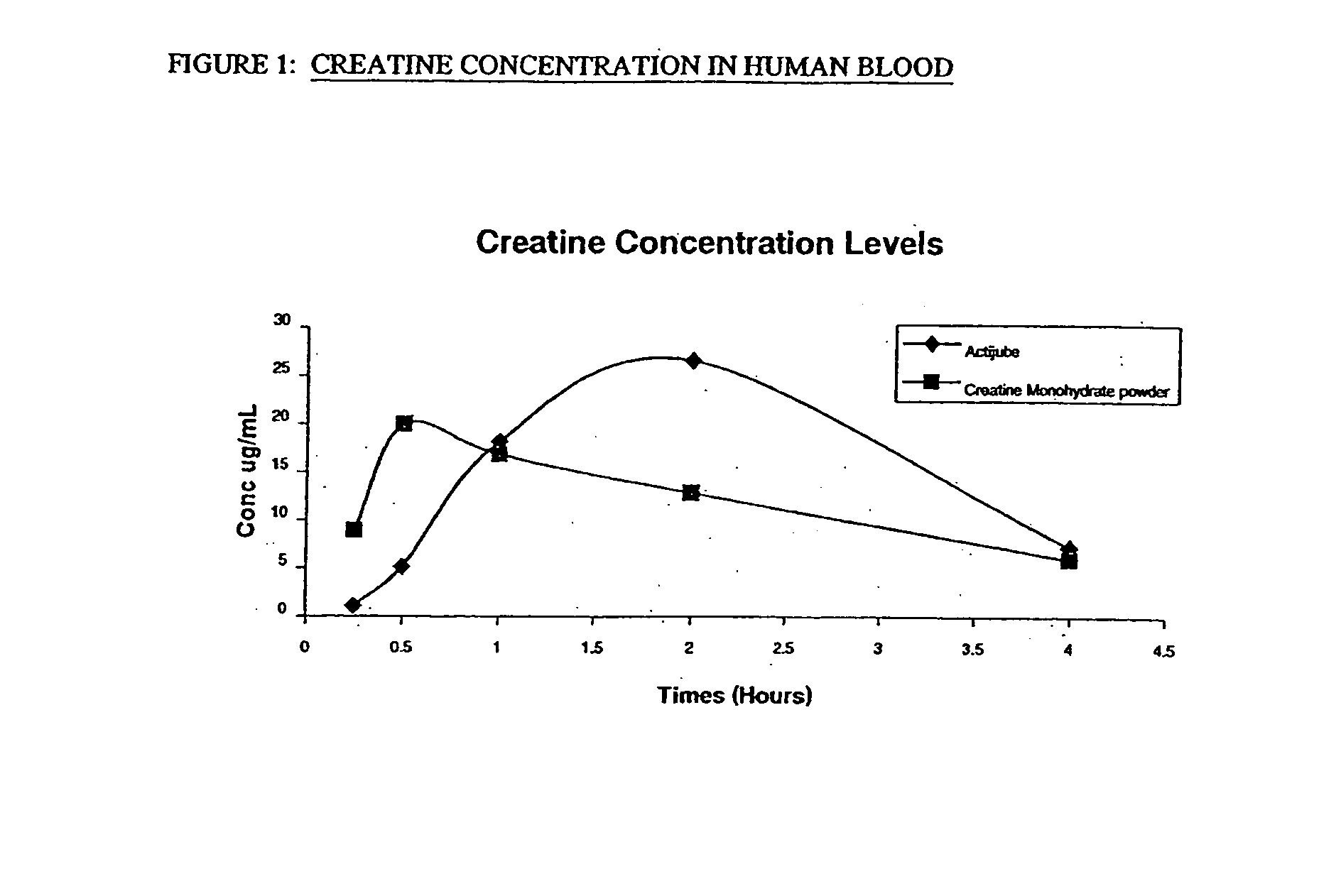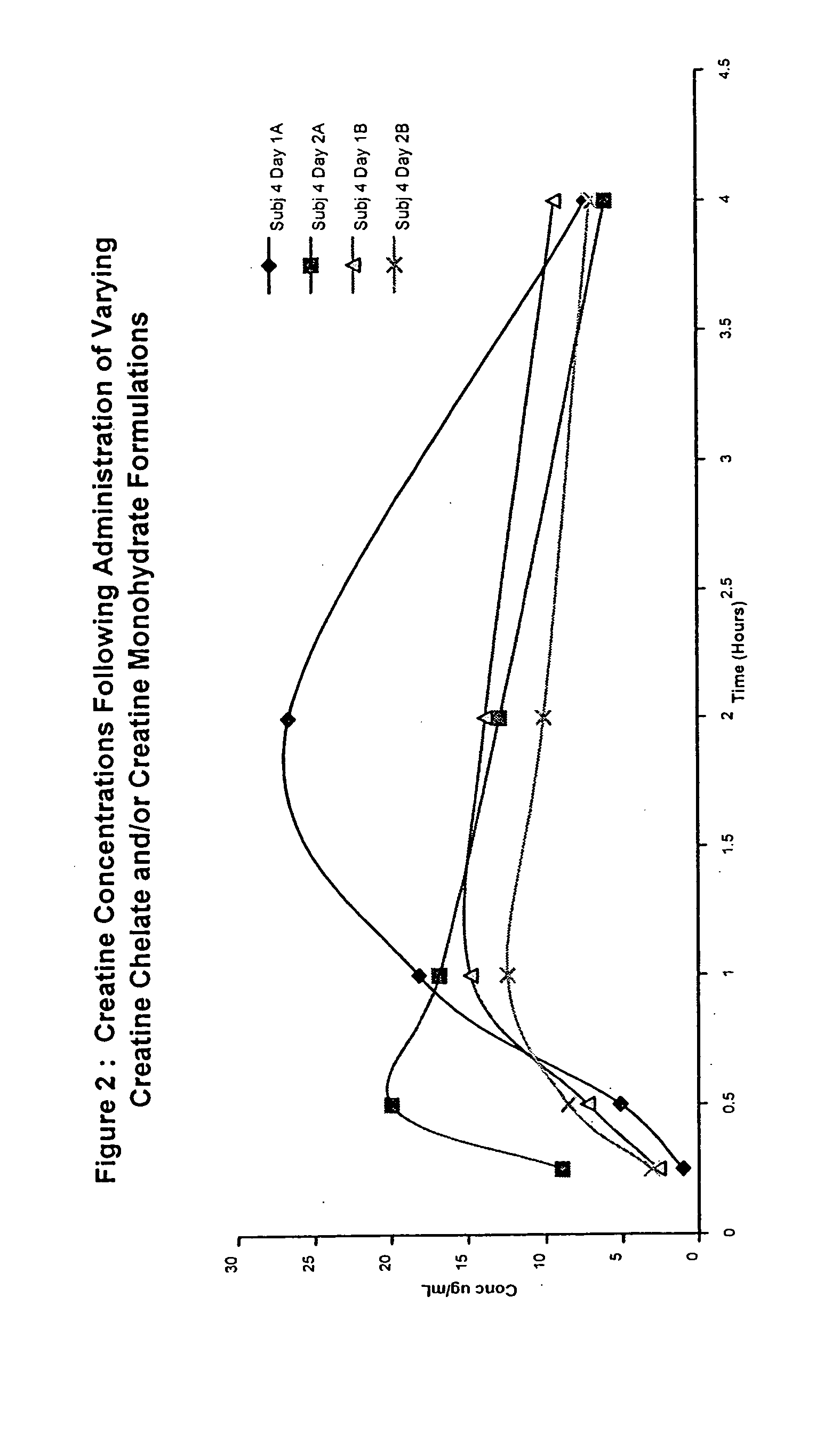Starch-based delivery system for creatine
a delivery system and creatine technology, applied in food preparation, food shaping, food science, etc., can solve the problems of not being well absorbed by the gastrointestinal tract, degrading the most bioavailable creatine in meat, and certain side effects
- Summary
- Abstract
- Description
- Claims
- Application Information
AI Technical Summary
Benefits of technology
Problems solved by technology
Method used
Image
Examples
example 1
Exemplary Formulations
[0139] Examples of possible formulations of creatine alone or with other bioactive agents suitable for incorporation into the delivery system of the present invention include: (1) creatine alone; (2) creatine with extracts for performance enhancement (e.g. rodiola crenulata mix (from PharmEast)); (3) creatine with extracts for thermogenic enhancement such as a diuretic, metabolic enhancer (extract from PharmEast); (4) creatine with extracts for alertness and mental enhancement such as gingko biloba, phosphatidyl serine or choline, CoQ10; (5) creatine with extracts for muscle enhancement such as solubilized isoflavones; (6) creatine with vitamins and / or minerals and (7) creatine with extracts for general performance enhancement and health such as yohimbe, gingko, puanama muira, and saw palmetto.
example 2
Delivery Systemfor Creatine
[0140] An example of a delivery system containing creatine alone is as follows:
1 Ingredient % by Weight Glycerol 14.82% Propylene Glycol 5.39% Creatine monohydrate 11.91% Corn Syrup 62DE 32.33% Sucralose 0.04% Modified Starch (Staley Softset .RTM.) 2.70% Potassium citrate 2.19% High fructose corn syrup 9.43% Water 14.82% Gelatine 100 bloom type B 1.34% Gelatine 250 bloom type A 4.04% Gellan (Kelcogel .RTM. LT100) CP Kelco 0.33% Colour 0.21% Flavour 0.46% Total: 100.00%
[0141] Glycerol and propylene glycol were first blended and the creatine was then added. The blend was heated to 65-70.degree. C. In a separate container, the two types of gelatine and the gellan were blended together. The fructose syrup and water were mixed and heated to 60.degree. C., after which the gelatine:gellan mixture was added. The mixture was then heated to 75.degree. C. to allow the components to dissolve. In a third container, the corn syrup was warmed to 30-35.degree. C. and the ...
example 3
HPLC Analysis of Creatine Stability
[0143] Samples of the delivery system produced by the method described in Example 2 were analyzed by high performance liquid chromatography (HPLC) using UV detection to determine the percentage of creatine. Prior to injection, each sample was subject to a dissolution procedure wherein the sample was cut into small pieces and heated in 400 ml of Type 1 water at 90.degree. C. for 10 minutes. The samples were then transferred to a water bath at 4.degree. C. and 50 ml of 1% perchloric acid was added. The mixture was then heated to 28.degree. C., transferred to a 500 ml volumetric flask and the volume made up to 500 ml with Type 1 water. A 60 .mu.L aliquot of this solution was then added to 140 .mu.L of methanol and vortexed. Three replicates were prepared for each sample. Samples of 10 .mu.L of the final solution were used to inject into the HPLC.
[0144] The percentage of creatine (by weight) was determined by comparing the mean response of creatine in ...
PUM
 Login to View More
Login to View More Abstract
Description
Claims
Application Information
 Login to View More
Login to View More - R&D
- Intellectual Property
- Life Sciences
- Materials
- Tech Scout
- Unparalleled Data Quality
- Higher Quality Content
- 60% Fewer Hallucinations
Browse by: Latest US Patents, China's latest patents, Technical Efficacy Thesaurus, Application Domain, Technology Topic, Popular Technical Reports.
© 2025 PatSnap. All rights reserved.Legal|Privacy policy|Modern Slavery Act Transparency Statement|Sitemap|About US| Contact US: help@patsnap.com


